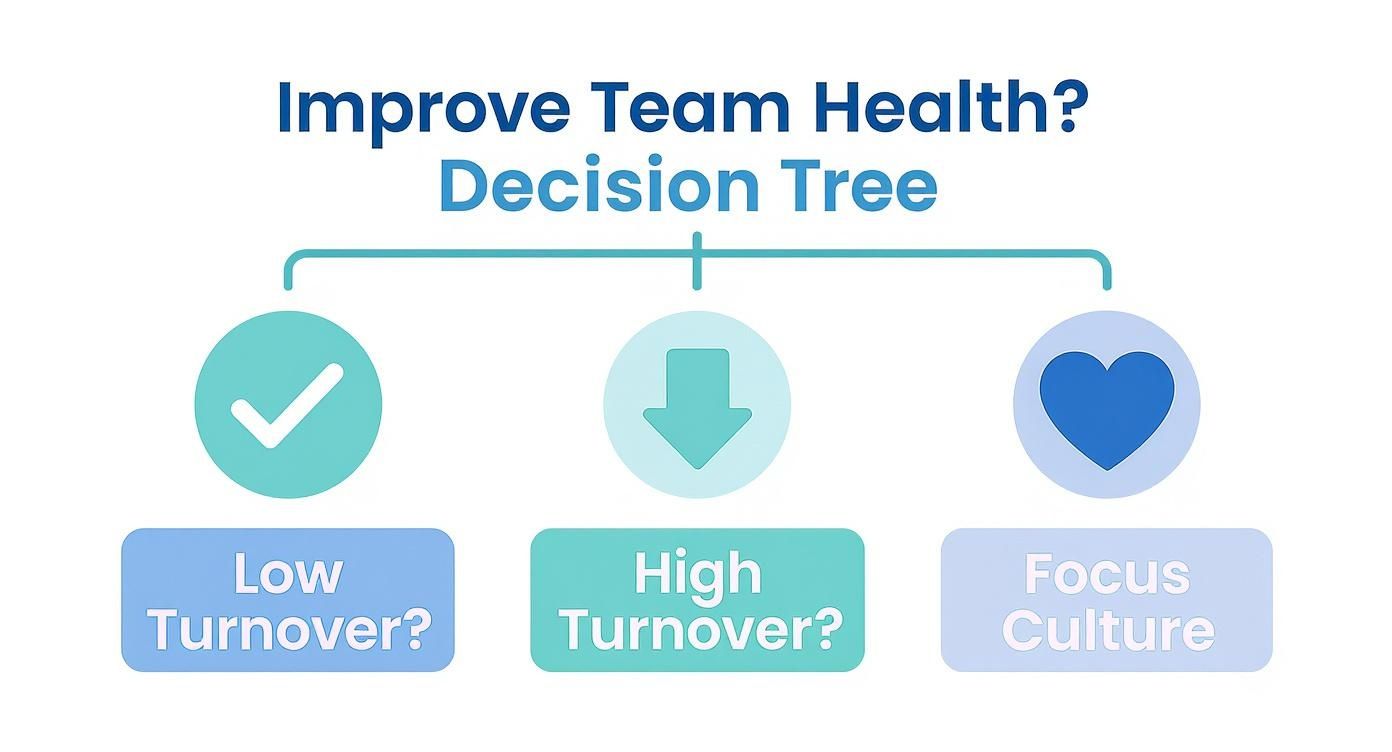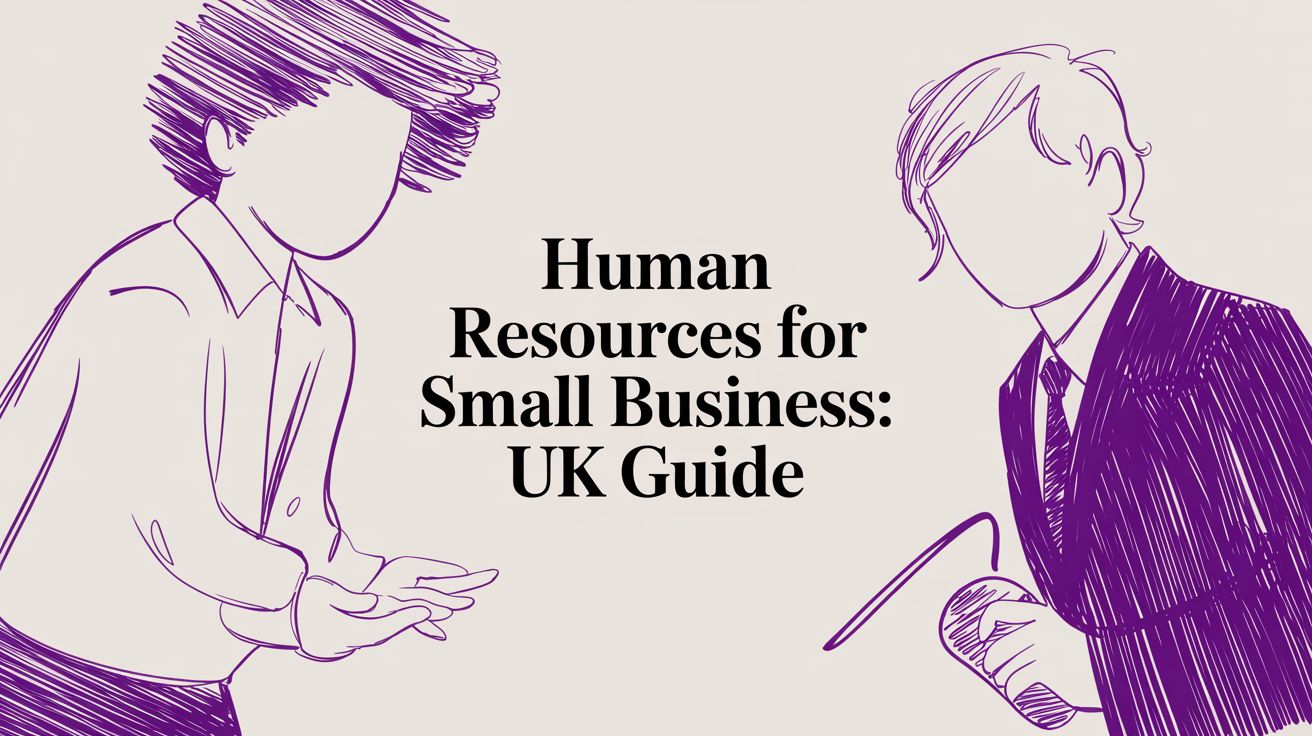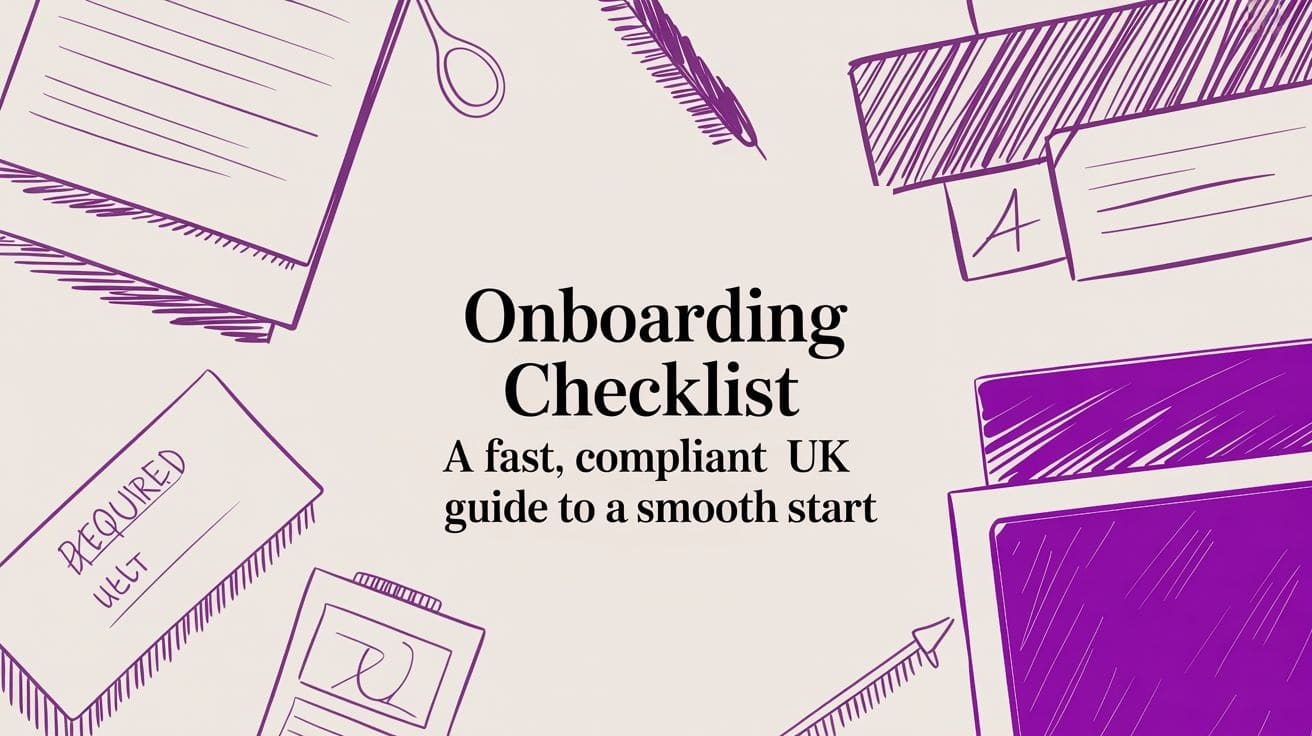For many small business owners, “human resources” sounds like a bit of corporate jargon—something for the big players, not for a growing team. But that couldn’t be further from the truth. Good HR isn’t about red tape; it’s the operational engine that keeps your business running, growing, and thriving.
It’s about moving beyond the must-dos, like contracts and Right to Work checks, and building a strategy that boosts productivity, keeps morale high, and makes your best people want to stay.
The Hidden Engine of Your Small Business Growth

Imagine your business is a ship. Your customers and competitors see the polished deck and the impressive sails catching the wind. But what they don’t see is the powerful, well-oiled engine below deck that’s actually driving you forward.
For any small business, that engine is your people. And HR is the system that keeps it running smoothly and efficiently.
Too many entrepreneurs see HR as a box-ticking exercise, a necessary evil for when you get big enough. But this misses the point entirely. Without a solid approach to managing your team from the early days, you’re setting yourself up for serious growing pains that can stop you in your tracks.
Why HR Is a Growth Multiplier
Thinking about human resources for small business as a growth multiplier, rather than just an administrative cost, is a game-changer. When you get it right, you sidestep common pitfalls and build a team that’s resilient and high-performing.
Let’s break down what a proper HR foundation actually does for you:
- Minimises Compliance Risks: It helps you navigate the maze of UK employment law, from getting contracts right to handling data in a GDPR-compliant way. This protects you from potentially crippling legal headaches down the line.
- Improves Hiring Outcomes: A proper recruitment process helps you find people who don’t just have the skills on paper, but who genuinely fit with the culture you’re trying to build.
- Increases Employee Retention: When you focus on keeping your team engaged, supported, and developing, you drastically cut the huge cost—both financial and cultural—of staff turnover.
- Enhances Productivity: Clear policies, fair performance management, and consistent leadership create an environment where people know what’s expected of them and feel motivated to contribute to the company’s goals.
In essence, investing in HR is investing directly in your business’s future. It provides the framework needed to scale effectively, maintain a strong culture, and create a workplace where your best talent chooses to build their careers.
This is particularly vital in the UK, where small and medium-sized enterprises (SMEs) are the lifeblood of the economy. UK SMEs employ around 16.6 million people—that’s roughly 60% of the entire private sector workforce.
And with 99.2% of these businesses having fewer than 50 employees, the performance of every single person has a direct, measurable impact on the bottom line. If you’re curious, you can explore more fascinating UK small business statistics to get a fuller picture.
This guide is designed to demystify HR and show you how to build a system that really works for your business. We’ll take you on a practical journey, from the days of wrestling with spreadsheets to the point where you’re using smart, integrated systems to create a truly great place to work.
To discuss how to build a powerful HR engine for your business, call us on 0845 855 0000 today.
Building a Compliant HR Foundation

When you’re running a small business, getting the basics of HR right isn’t just about being a good employer—it’s the law. Building a legally sound foundation from day one is your best defence against costly tribunals and hefty fines, giving you the peace of mind to grow your business with confidence.
Think of it like building a house. You wouldn’t dream of picking out furniture before you’ve laid a solid foundation that meets all the building codes. In the world of HR, that means getting your contracts, checks, and policies watertight before you even think about bringing your first employee on board.
This section will cut through the legal jargon and give you a straightforward guide to the absolute essentials. We’ll walk through the non-negotiables of UK employment law, making sure every legal box is ticked.
Mastering Employment Contracts
The employment contract is the cornerstone of your entire relationship with an employee. It’s a legally binding agreement that clearly defines the terms and conditions of their employment, and any mistakes here can lead to serious disputes down the line.
In the UK, you have a legal duty to give a new employee a ‘Statement of Main Terms’ (often called a Section 1 Statement) on or before their very first day. This document must contain all the essential information about their role.
While the Statement of Main Terms is the bare legal minimum, a full employment contract is what we’d always recommend. It offers far more comprehensive protection for both you and your employee by covering crucial details that prevent ambiguity.
-
Statement of Main Terms (The Must-Haves): This covers the basics, such as the names of the employer and employee, start date, job title, pay, hours of work, holiday entitlement, and notice periods.
-
Full Employment Contract (The Smart Move): This includes everything from the statement, but it also adds vital clauses on confidentiality, intellectual property, restrictive covenants, and detailed disciplinary and grievance procedures.
Conducting Correct Right to Work Checks
Before anyone starts working for you, you are legally required to check that they have the right to work in the UK. Getting this wrong isn’t an option—it can result in a civil penalty of up to £60,000 per illegal worker. The process itself is straightforward, but it has to be followed to the letter.
You must check original documents, confirm they are genuine with the person present, and take a clear copy for your records. It’s also vital to understand the different types of workers you might engage. To get a better grasp on this, you can learn more about what a contingent worker is in our detailed guide.
A common mistake is to only check passports. The Home Office provides a comprehensive list of acceptable documents, and you must follow their guidance meticulously to ensure you are compliant.
Managing Data and Statutory Leave
Handling employee data correctly is another critical piece of the puzzle for human resources for small business. Under UK GDPR, you must have a lawful reason for processing personal data, keep it secure, and only hold it for as long as is necessary. This applies to everything from CVs and application forms to payroll and sickness records.
Statutory leave entitlements are also a key part of your legal duties as an employer. In the UK, this includes:
-
Holiday Pay: Almost all workers are legally entitled to 5.6 weeks’ paid holiday per year. This is often referred to as statutory leave entitlement or annual leave.
-
Sick Pay: If they’re too ill to work, your employees may be eligible for Statutory Sick Pay (SSP).
-
Parental Leave: This covers maternity, paternity, adoption, and shared parental leave. Each has its own specific rules on eligibility, pay, and duration that you need to get right.
To help you stay on track, we’ve put together a simple checklist covering the essential compliance areas for any UK small business hiring staff.
Essential HR Compliance Checklist for UK Small Businesses
Here’s a quick-glance table to help you nail the fundamentals of HR compliance when hiring and managing your team in the UK.
| Compliance Area | Key Action Required | Why It Matters |
|---|---|---|
| Employment Contracts | Provide a ‘Statement of Main Terms’ on or before day one of employment. | It’s a legal requirement that establishes clear expectations and protects both parties. |
| Right to Work Checks | Verify and copy original documents for every new hire before their start date. | Avoids substantial fines (up to £60,000 per worker) and legal penalties. |
| UK GDPR Compliance | Establish a clear policy for handling, storing, and deleting employee data securely. | Protects employee privacy and prevents significant data breach fines from the ICO. |
| Statutory Leave | Accurately calculate and manage holiday, sick, and parental leave entitlements. | Ensures you meet your legal obligations and treat employees fairly, avoiding disputes. |
Nailing these foundational elements gives you the stability you need to stop worrying about compliance and start focusing on growing your team and your business.
To ensure your HR foundation is fully compliant and built for growth, ring 0845 855 0000 today.
Keeping Your Best People on Board
Once you’ve got the essential, legally-sound HR foundations in place, your focus can shift from simply ticking boxes to building a genuinely great place to work. The conversation changes from “what must we do?” to “what can we do?”. This is where human resources for small business moves beyond admin and starts creating a culture that makes your best people want to stick around.
Losing a great team member is a massive headache for any business, but for a small one, the impact can be huge. The cost isn’t just about recruitment fees; it’s the lost knowledge, the dip in productivity, and the time spent training someone new. A solid strategy for keeping your team happy isn’t a ‘nice-to-have’—it’s a smart business investment.
This forward-thinking approach is often called ‘People Operations’. It’s all about treating your employees as key contributors whose experience at work directly impacts the company’s success. The best part? You don’t need a massive budget to make a real difference.
Crafting a Simple and Effective Review Process
Let’s be honest, performance reviews often get a bad name. They can feel like a stuffy, bureaucratic chore. But for a small business, a simple, consistent review process is one of the most powerful tools you have for communication and growth. It’s your chance to connect individual goals with the bigger company picture, give helpful feedback, and find out what really motivates each person on your team.
You can forget about complicated, multi-page forms. A great review process can be built around a few simple questions:
- What have you achieved since our last chat that you’re proud of?
- What challenges are you running into, and how can I help?
- What skills would you like to build over the next six months?
- How can we, as a company, make your job better?
Often, regular and informal check-ins work far better than one big, formal review each year. This keeps the conversation going, builds trust, and lets you sort out small niggles before they grow into major problems. The aim here is dialogue, not judgement.
A well-run review process should feel like a supportive conversation focused on the future. It signals to your team that you are invested in their personal and professional development, which is a cornerstone of employee retention.
Embracing Flexibility and Recognition
In today’s working world, flexibility is gold. As a small business, you might not be able to compete with corporate salaries, but offering flexible working can be a game-changer. This could be anything from a hybrid model to adjusted start and finish times or even compressed hours.
Beyond flexibility, creating a culture where people feel recognised is vital. This doesn’t have to mean big, expensive bonuses. Simple, heartfelt acknowledgement of a job well done goes an incredibly long way. A shout-out in a team meeting, a handwritten thank-you note, or a small gift card for going the extra mile all help build an atmosphere where people feel genuinely seen and valued.
Investing in Your Team’s Growth
One of the most powerful ways to keep your team on board is to invest in their skills. This is a trend that’s really picking up steam across the UK. A recent study found that a remarkable 70% of UK SMEs plan to invest in developing their workforce this year, focusing on upskilling their current teams instead of just hiring new people.
This shift is partly a reaction to a tough recruitment market, with 26% of SMEs admitting they struggle to find candidates with the right skills. You can explore more insights into UK SME business trends to see the bigger picture.
When you offer training and development, you’re sending a powerful message: “we believe in you, and we want you to grow with us.” This not only boosts loyalty but also creates a more skilled and adaptable team that directly benefits your bottom line.
To put these strategies into action and build a workplace your team won’t want to leave, ring 0845 855 0000 today.
Measuring the Metrics That Actually Matter
You can’t manage what you don’t measure. Once you’ve got your compliance sorted and are actively building a positive culture, it’s time to start looking at the numbers. This isn’t about getting bogged down in complex analytics; it’s about using a few simple, powerful figures to understand the real health of your team and make smarter decisions.
Think of these metrics as the dashboard in your car. You wouldn’t set off on a long journey without glancing at the fuel gauge or the engine temperature. In the same way, HR metrics give you a clear, real-time view of what’s happening with your most valuable asset: your people.
A basic spreadsheet is a perfectly good place to start. The aim here is to shift from guesswork to informed action, and a handful of essential KPIs (Key Performance Indicators) will show you exactly where your attention is needed most.
Employee Turnover Rate
This is probably the big one for any small business. It simply tells you the percentage of employees who leave your company over a set period. A high turnover rate is a massive red flag, often pointing to problems with company culture, management style, or how you reward your team.
The financial hit is serious. For small UK businesses, where the median revenue is £295,000 and average profits hover around £70,000, losing even one person can be a major blow. You can discover more about the financial landscape of UK small businesses to see just how much every penny counts. Replacing someone means recruitment fees, training hours, and lost productivity – all of which come straight off your bottom line.
How to Calculate It:
(Number of Employees Who Left ÷ Average Number of Employees) x 100 = Turnover Rate %For a UK SME, a ‘good’ annual turnover rate is generally below 15%, but this can definitely vary depending on your industry.
Absence Rate
The absence rate tracks how much time your team loses to unplanned leave, like sickness. Of course, some absence is inevitable. But a consistently high rate can hint at deeper issues like low morale, employee burnout, or a stressful work environment.
Tracking this helps you see patterns before they become problems. Is one particular team calling in sick more often? Are absences spiking at certain times of the year? Answering these questions lets you get ahead of issues before they really take hold.
- How to Calculate It: (Total Lost Workdays ÷ Total Scheduled Workdays) x 100 = Absence Rate %
- What It Means: The UK average sits around 2.9%. If you’re consistently seeing a figure above 4%, it’s probably time to dig a little deeper.
Time to Hire
This metric is all about speed and efficiency. It measures the average number of days it takes to fill a job, from the moment the advert goes live to the new hire signing their contract. A long Time to Hire might mean your recruitment process is clunky or that you’re finding it hard to attract the right people in the first place.
This has a direct impact on your day-to-day operations. A crucial role sitting empty for weeks puts a strain on the rest of the team and can easily lead to missed business opportunities. Keeping an eye on this number helps you sharpen up your hiring strategy to get great people through the door, faster.
- How to Calculate It: Total days all jobs were open ÷ Number of jobs filled = Average Time to Hire
- A Good Benchmark: For most roles in a small business, aiming for 20-40 days is a realistic and healthy target.
By keeping tabs on just these three straightforward metrics, you’ll gain a surprisingly clear picture of your team’s stability, their engagement, and how well you’re attracting new talent. This is the foundation of moving HR from a reactive task to a strategic part of your business.
To get expert guidance on measuring what matters for your business, call 0845 855 0000 today.
When to Ditch the Spreadsheets for HR Tech
Let’s be honest, for most small businesses, the humble spreadsheet is the first port of call for HR. It manages everything from holiday requests to employee contact details. It’s familiar, it’s free, and when you only have a handful of people, it seems to get the job done.
But as your team grows, that once-simple solution quickly spirals into a tangle of administrative headaches and hidden risks. There’s a definite tipping point where wrestling with manual processes starts costing you far more in time, errors, and missed opportunities than you could ever save.
Managing human resources for small business this way inevitably leads to admin overload. You also face a much higher risk of compliance breaches with data scattered everywhere, and you have absolutely no clear insight to make smart decisions about your people. Recognising you’ve hit this wall is the first step.
The Telltale Signs You’ve Outgrown Spreadsheets
Is HR admin starting to feel like a full-time job in itself? If you find yourself nodding along to these classic pain points, it’s a clear signal that your spreadsheets are holding you back.
- You’re Drowning in Admin: You or your managers are losing hours every week manually updating holiday trackers, chasing down signed contracts, and trying to pull together basic information for payroll.
- Compliance is a Constant Worry: Is that Right to Work check saved in the right folder? Is everyone’s data GDPR compliant? When employee info is spread across multiple files and emails, it’s almost impossible to be sure you’re compliant, let alone ready for an audit.
- There’s No Single Source of Truth: An employee moves house. Does their address need updating in three different spreadsheets? Without one central system, your data quickly becomes inconsistent, out of date, and totally unreliable.
- You’re Flying Blind Strategically: Spreadsheets can tell you who works for you, but they can’t easily reveal your staff turnover rate, patterns in sick leave, or who is overdue a performance review. You’re making critical people decisions without the data to back them up.
This infographic neatly shows how these kinds of issues, like high turnover, should trigger a strategic rethink.

As the visual points out, high turnover is a huge red flag. It’s a symptom that forces you to look deeper at your company culture—a task made infinitely easier when you have real data from a proper HR system.
The Strategic Leap to an Integrated Platform
Moving on from spreadsheets isn’t just about buying a piece of software. It’s a strategic shift in how you manage your people. This is where modern, scalable platforms, especially those built on the Microsoft Dynamics 365 ecosystem, can be a game-changer. They give you a central, secure hub for all things HR and automate the mundane tasks that drain your day.
A dedicated HR platform transforms HR from a reactive, paper-pushing job into a proactive, strategic asset. It frees you up to focus on what actually matters: supporting and developing your brilliant team.
Think about recruitment. Instead of tracking candidates in a messy spreadsheet, you can use a proper system to manage your entire hiring pipeline from start to finish. If that’s a particular pain point, our guide on what is an applicant tracking system explains exactly how this technology can help.
To really see the difference, let’s compare the old way with the new.
Manual HR vs. Integrated HR Platform
| HR Function | Spreadsheet Approach (The Pain) | Integrated Platform (The Gain) |
|---|---|---|
| Onboarding | A chaotic checklist in a document, manual reminders for IT, and chasing signed contracts via email. | A streamlined, automated workflow. The new hire gets a welcome pack, tasks are assigned to the right people, and all documents are signed and stored digitally. |
| Holiday & Absence | Clunky holiday request forms, a shared calendar that’s never up-to-date, and manual calculations of remaining leave. | A self-service portal for staff to request time off. Managers approve with one click, and balances are updated automatically for everyone to see. |
| Employee Data | Personal details, salary info, and emergency contacts are scattered across multiple, unsecured files. It’s a GDPR nightmare. | One secure, central record for each employee. Staff can update their own details, and access is tightly controlled. Easy to audit, easy to manage. |
| Performance Reviews | Notes from meetings are buried in random Word docs. It’s impossible to track goals or see progress over time. | A structured process where objectives are set and tracked. Both managers and employees can see performance history, making reviews meaningful. |
The table makes it clear: one approach creates admin and risk, while the other creates efficiency and insight. It’s a simple choice when you see it laid out like that.
A Simple Cost-Benefit Analysis
Of course, the idea of paying for software can feel like a big step for a small business. But it’s crucial to weigh that subscription fee against the hidden costs of sticking with spreadsheets.
First, calculate the hours your team spends on HR admin each month. Now, multiply that by their hourly rate. That figure alone is often a wake-up call.
Then, add the financial risk of a compliance mistake. A single GDPR breach or an incorrect Right to Work check can result in fines running into thousands of pounds. When you compare these costs to a typical HR software subscription—which can start from as little as £3-£5 per employee per month—the return on investment becomes glaringly obvious.
You’re not just buying software; you’re investing in efficiency, security, and peace of mind.
To explore how a dedicated HR solution can support your business, ring 0845 855 0000 today.
Taking the Next Step in Your HR Journey
We’ve covered a lot of ground together, stepping through the entire world of human resources for small businesses. From getting your legal house in order to thinking more strategically about your people, you now have the building blocks. You’ve seen how to build a compliant foundation, hold onto your best people, measure what actually matters, and spot the signs that it’s time to ditch the spreadsheets.
Good HR isn’t a one-and-done project. It’s an ongoing commitment to making your business a better place to work and helping your team flourish.
Whether your top priority right now is writing your first proper employment contract or you’re starting to think about how technology could handle the admin, you now have a roadmap. The move from manual paperwork to strategic people operations is a big one, but every step you take makes your business stronger and more resilient.
From Knowledge to Action
You’re now armed with the insights to make a real difference. The trick is to start with your most urgent problem and build from there.
Maybe that’s putting a simple performance review process in place. Or perhaps it’s finally starting to track your employee turnover rate. Whatever you choose, every small action strengthens the very core of your business.
Remember, the whole point of great HR is to create an environment where your people can do their best work. That’s what builds a positive culture, which doesn’t just keep your talent around—it directly fuels your bottom line and long-term success.
For businesses already running on Microsoft, integrating these HR functions into the system you already know can be a game-changer. To see what a dedicated solution looks like, have a look at our detailed guide on Human Resources HR for Dynamics 365. It shows how you can get a single, secure platform to manage everything from recruitment to retirement.
To get started with expert guidance that’s shaped around your specific needs, give us a ring on 0845 855 0000 today.
Got Questions About Small Business HR? We’ve Got Answers.
Jumping into the world of human resources can feel like learning a new language, especially when you’re also trying to run a business. We get it. Here are some straightforward answers to the questions we hear most often from UK business owners just like you.
When Is It Time to Hire My First HR Person?
This is the big one, isn’t it? Forget a magic number of employees; the real signal is when HR tasks start pulling you away from what you do best—growing your business.
It’s probably time to bring in some HR help, even if it’s just part-time, when you find yourself in these situations:
- You’re losing more than a day a week to HR admin. Think about it. That’s precious time that could be spent on sales, strategy, or product development.
- You’re dealing with tricky people problems. Formal grievances, disciplinary issues, or handling long-term sickness can get complicated fast. Getting it wrong is risky, so expert guidance is invaluable.
- You’re about to grow—quickly. If you’re planning a hiring spree, you need a solid foundation. An HR professional can build the recruitment and onboarding engine you need to scale without chaos.
The tipping point is simple: it’s when managing people stops being a small part of your job and starts becoming the job. A dedicated HR expert takes that weight off your shoulders, keeps you compliant, and helps you build a brilliant team while you get back to business.
What Does Outsourced HR Support Actually Cost in the UK?
The cost for outsourcing your HR can swing quite a bit, but it all comes down to what level of support you need. For small UK businesses, the pricing usually breaks down into a few common-sense models.
- Monthly Retainer: This is the most popular route. You pay a set fee each month for ongoing advice and support. Costs can be anywhere from £200 to over £1,000 per month, depending on your company’s size and what’s included. A basic plan might just give you an advice line, while a more comprehensive one could include site visits and strategic help.
- Pay-As-You-Go: Perfect for when you only need help now and then for a specific issue, like managing a redundancy or a tricky disciplinary hearing. You’ll be billed by the hour, typically between £75 and £250+.
- Project-Based Work: If you need a one-off job done, like creating a brand new employee handbook or rewriting all your employment contracts, you’ll usually be quoted a fixed fee. This gives you total clarity on the cost from the start.
How Do I Handle a Disciplinary Procedure Fairly?
Getting disciplinary procedures right is non-negotiable. It protects you from the very real risk of an unfair dismissal claim. The secret is to follow a fair, consistent, and documented process. In the UK, the ACAS Code of Practice on Disciplinary and Grievance Procedures is your bible.
A fair process always includes these core steps:
- Investigate Properly: Before you do anything else, you must investigate the issue thoroughly and impartially to get the facts straight.
- Inform the Employee in Writing: Send a letter to the employee explaining the allegations clearly. Give them all the details so they can understand the case and have a reasonable amount of time to prepare.
- Hold a Disciplinary Hearing: This is their opportunity to respond to the allegations and tell their side of the story. They have a legal right to bring a colleague or a trade union rep with them.
- Decide on an Outcome: After the hearing, take some time to review everything before making a decision. The outcome could be anything from a verbal warning to dismissal, depending on how serious the misconduct was.
- Offer the Right to Appeal: You must confirm your decision in writing and let the employee know they have the right to appeal it.
Following these steps isn’t just bureaucratic box-ticking; it’s about being fair to your people and protecting your business.
At DynamicsHub, we help businesses turn HR from a manual headache into a strategic advantage. To see how our Microsoft-centric solutions can support your growth, give us a ring on 0845 855 0000 today.



